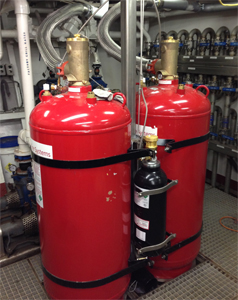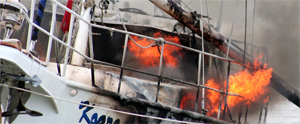Fire on the water is serious business — every mariner knows that. Fortunately, the tools of fire suppression have greatly improved over the years. But there may be troubled waters ahead.
For decades the old standby, water, has been supplemented in many maritime applications by halon, chlorofluorocarbon compounds (CFC), carbon dioxide (CO2) or a variety of newer hydrofluorocarbons (HFCs) with strong fire suppression capabilities. Halon — a banned substance due to its ozone-depleting characteristics — is now mostly history. CO2, meanwhile, has serious life-safety concerns: It’s potentially deadly and its application in confined spaces can quickly impact crew.
Hydrofluorocarbons were supposed to be the answer and have been popular in recent years. However, environmental advocates have noted that a single discharge of a typical HFC system can emit greenhouse gases equivalent to driving a car tens of thousands of miles.
So far that has not had an impact on the use of the systems in North America, but it likely will, according to Ernie Ellis, owner of Sea-Fire Marine, a Baltimore, Md.-based provider of marine firefighting equipment.
“Environmental considerations are continuing to gain momentum and attention throughout the world, including the USA and Canada,” he said. In general, he noted, consumers are becoming more conscious of their environmental impact — millennials especially so.
In the 1990s, halon fire suppressant was subjected to a comparable analysis as an ozone-depleting chemical. “The Montreal Protocol (a 1987 international treaty) phased out halon production, and Europe took the more aggressive lead on the ban of CFCs with other countries eventually following,” Ellis said.
 |
|
FM-200 cylinders are shown inside the fish processor Island Enterprise in this file photo from 2013. The fire suppressant is still listed as acceptable for the total flooding of occupied spaces when used as specified by the Environmental Protection Agency. |
|
Courtesy Gregory Schuler |
HFCs, which are now considered objectionable due to their global warming potential (GWP) — a measurement designed to allow comparisons of the global warming impacts of different gases — seem to be on a similar path to oblivion.
Hydrofluorocarbons have been subject to scrutiny beyond the United Nations’ Paris Agreement, a pact negotiated by 196 state parties in 2015 that limited greenhouse-gas emissions. For example, in 2016 the New York Declaration on Forests called attention to the carbon impacts of HFCs and urged a global reduction in the use of the compounds. Later that same year, negotiators from 197 countries met at a summit of the United Nations Environment Program in Kigali, Rwanda, and reached a binding agreement to phase down HFCs.
That has effectively put most of the world, particularly Europe, on track to eventually eliminate HFCs, though the specifics typically do not demand the elimination of existing HFC systems.
“Currently there is no national legislation in the USA or Canada phasing out HFCs as there is in Europe, Australia and various Scandinavian countries,” Ellis said.
According to the U.S. Environmental Protection Agency (EPA), its Significant New Alternatives Policy (SNAP) program has evaluated and lists as acceptable, or acceptable with use restrictions, a number of HFCs for total flooding in marine fire suppression. For example, the EPA currently limits the use of HFC-236fa but does not prohibit or restrict the use of HFC-227ea (FM-200) or other HFCs for total flooding.
Similarly, Canadian regulations control the import, export, manufacture and certain uses of ozone-depleting substances and HFCs, as well as certain products that contain or are designed to contain HFCs, according to Environment and Climate Change Canada spokeswoman Samantha Bayard. The import of HFCs in bulk is subject to the U.N. Kigali phase-down schedule that began this year, but bulk HFC-based fire extinguishing agents such as FM-200 will continue to be allowed to be imported “in order to service existing equipment,” she said.
Even the California Air Resources Board (CARB), which often takes cutting-edge positions on environmental issues, has no immediate plans to ban high-GWP hydrofluorocarbons in new fire suppressants.
 |
|
In October 2016, representatives from 197 countries met in Kigali, Rwanda, and adopted an amendment to phase down hydrofluorocarbons under the Montreal Protocol. Although HFCs from fire suppressants make up a very small percentage of HFC emissions worldwide, they were not exempt from the agreement. |
|
Courtesy IISD Reporting Services |
“CARB is aware that a common fire suppressant, HFC-227ea, has a global warming potential that is 3,000 times greater than carbon dioxide, pound for pound,” said Melanie Turner, the agency’s public information officer. However, she added, CARB estimates that fire suppressants currently contribute less than 1 percent of all HFC emissions, while refrigerants contribute more than 90 percent.
That is why CARB is working on regulations to prohibit high-GWP agents in new refrigeration and air-conditioning systems. “After the refrigerant regulations are made final in 2020, CARB will assess the need for additional regulations to ban high-global-warming-potential HFCs from non-refrigerant sources, including fire suppressants,” Turner said.
On a national level, the comparatively easy-going response from U.S. regulators on HFCs is due in part to the Trump administration’s intention to withdraw from the Paris Agreement, according to Guy Colonna, senior director of the National Fire Protection Association (NFPA). The earliest that this officially could occur is November 2020, after the agreement takes effect, but federal regulators have already aligned with administration policy.
Colonna said the NFPA’s codes currently do not address the impact of substance bans. If a maritime operator has an installed system but doesn’t actually discharge the system, which would require replenishment, those agents can remain viable and in service, he said. On the other hand, if an operator discharges the system in an emergency and the substance used has been banned or is being phased out, there would be more challenges returning it to service, he added.
So, for the moment, U.S. and Canadian maritime operators do not face an urgent situation with regard to HFCs; still, the writing is on the wall. The European Union is reportedly on track to reduce and eventually eliminate HFCs over the coming years. Even the United Kingdom has reaffirmed its commitment, with or without a Brexit deal, to follow the same path.
With the current action on HFCs in Europe, Ellis said vessel builders now “understand the value of providing an environmentally responsible and sustainable fire suppressant system.” And he warned that supplies of HFC-based fire suppressants would eventually become limited and cost prohibitive.
“A potential boat owner, as well as the boatbuilder, should seriously consider the advantages of fitting an environmentally responsible fire suppressant-based system,” he said.

